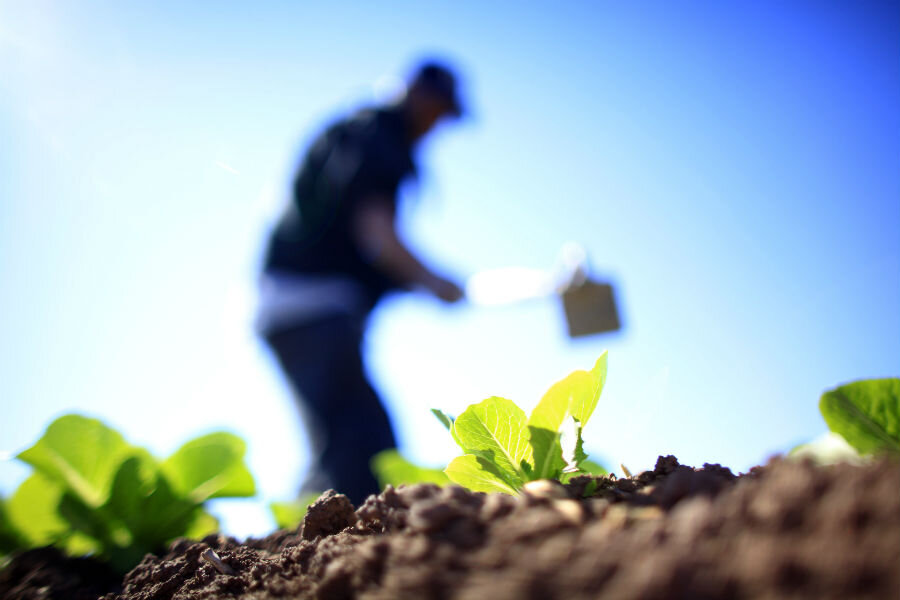Are robots taking over the farm? In Japan, they are.
Loading...
A Japanese firm said on Monday it will soon open what may be the most futuristic farm yet: operated by robots, with their human assistants donning lab coats instead of overalls, and vegetables growing vertically on ceiling-high metal shelves instead of horizontally over bucolic fields.
Spread, a cutting-edge food producer based in Kyoto, says its roughly one-acre indoor farm will start operating in 2017, producing 30,000 heads of pesticide-free lettuce a day initially. By using efficient lighting and watering, and shrinking the number of human employees, Spread will significantly reduce its costs, at least by half on labor.
The only job carried out by human farmers will be planting the seeds. All other tasks – from re-planting young seedlings to watering, trimming, and harvesting crops – are to be managed by machines.
While this new farm might be the most advanced representation of the high-tech shift in the global agriculture industry, it certainly isn’t the first. Farms worldwide have been turning to technology from drones to satellites to increase yields and replace workers as farmers struggle to feed a ballooning global population with a declining number of farmworkers.
"Around the world, we're facing increases in population and more and more environmental issues for farming," Shinji Inada, president of Spread, told CNN.
"As a company, we feel we need some new agricultural systems in order to survive and ensure the future for the next generation."
Statistics show that the next generation is not that interested in farming. Japan is facing labor shortages in agriculture and many other industries, and is expected to increasingly fill the open positions with robots. In 2011, the average age of a Japanese farmer was 65.9, according to the Guardian.
The US is in a similar situation. According to Stratfor Global Intelligence, an Austin, Texas-based analyst firm, the number of farmworkers in the US workforce decreased throughout the last century as per capita income increased. This is reflected in the 2012 US Census of Agriculture, which reported that the number of farmers declined between the 2007 and 2012 census by 4.3 percent, with a majority of farmers now between 55 and 64 years old.
An influx of undocumented and inexpensive Mexican laborers to the United States was what saved the agricultural sector from a labor crisis in the 20th century, Stratfor says. But immigration policy could soon render that unfeasible and cause labor costs to rise, and ultimately more robots to take over.
“Big data and smart technologies will play an increasingly important role in improving agricultural production in the United States over the course of the next 10 years,” predicted the firm in a 2015 report.
Though farmers are not going to be completely replaced by robots in the immediate future, they already are and will continue to rely heavily on the smart machines to produce more with less.
“Driverless tractors, drones that monitor soil quality, automated irrigation and even robotic bees to pollinate crops are all tools that farmers will have at their disposal as they seek to profit in a future of higher demand and fewer resources,” says Stratfor.
Since the 1990s, US dairy farmers have been using robots to milk cows. Genetic engineering has produced plants that can withstand powerful, chemical weed killers. Many industrial farms in the middle of the country use computers to operate farm machinery, employ automated seed planting technologies, and guide planting and harvesting decisions with information beamed down from satellites.
These trends may make Spread’s mechanical farm seem less exotic. The one due to open this year will be the company’s second (and more automated) facility, with the first already producing a harvest of 21,000 heads of lettuce that are delivered daily to supermarkets and restaurants across the country.
"In the beginning people reacted to our product as something unnatural – machine-like – but by continuing to sell in the supermarkets people started to realize slowly that the taste was good and there were health benefits, so we slowly gained customers,” Mr. Ianada told CNN.
"The turning point was the incident in 2011 at the Fukushima nuclear facility. After what happened there, people became more aware of the importance of safe food and it kind of turned the tables for us," he said.
CNN notes a few additional benefits of vertically grown vegetables. For one, they don’t require pesticides. The indoor factory is also clean, unsusceptible to weather and environmental conditions, and can be more easily monitored for disease.
“It is more reminiscent of a microchip factory than a farm, but the payoff is that each head of lettuce is so clean that consumers could eat it straight out of the bag,” writes CNN.







